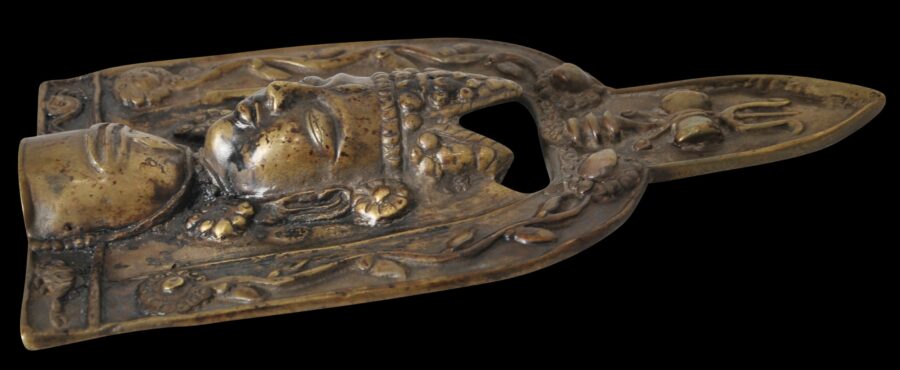This cast brass facial representation of Shiva known as a mohra is unique to Himachal Pradesh in northern (Himalayan) India.
It comprises a crowned Shiva head and upper body surrounded by foliage motifs and topped by an arched peak cast with a double hand drum topped by a trident (emblems of Shiva).
Shiva’s face has fine, almond-shaped eyes, a third eye on the forehead, and prominent eyebrows and nose. The large ears are elongated and with prominent ear pendants.
The section behind the crown is pierced.
The lower frieze on each side of the deity’s body is cast on one side with a coiled snake, and a scorpion on the other.
The upper body itself is marked with three horizontal lines supposedly of vibhuti, a sacred white ash, which acts as a reminder of the temporary nature of the material world. The three lines are known as tripundra and represent Shiva’ s three-fold powers of will, knowledge and action. The diamond-shaped lozenge just above the tripundra probably represents the creative energy of the Goddess Shakti.
Mohras were kept in groups in shrines in eastern Himachal Pradesh, fixed to wooden palanquins or rathas. They were used in conjunction with annual festivals and rituals when the ratha carrying the mohras and adorned with flowers, would be carried in processions.
The age of a mohra was not important to its spiritual veracity: often they were recycled – they were melted to create new ones. They were usually related to local deities and heroes, as well as Shiva. The depiction of snakes on a mohra is not uncommon – snakes were associated with both fertility and the deceased, given that their realm was supposed to be the underworld where the dead dwelt.
The surface of the mohra, front and back, is particularly smooth from handling and age.
References
Aryan, S. & B.N. Ayran, Unknown Masterpieces of Indian Folk and Tribal Art, KC Aryan’s Home of Folk Art, 2nd & enlarged ed., 2016.
Pal, P., Himalayas: An Aesthetic Adventure, The Art Institute of Chicago, 2004.
Postel, M., A. Neven & K. Mankodi, Antiquities of Himachal, Project for Indian Cultural Studies, Volume 1, Bombay, 1985.





